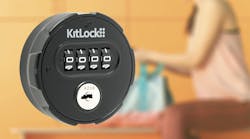Since active shooter preparedness became part of our national conversation over a decade ago, response strategies have evolved. A primary emphasis on physical lockdown capabilities and procedures has given way to more comprehensive response plans – of which lockdown is just one element. That said, lockdown capabilities and technologies remain a critical component of these strategies by restricting an assailant’s ability to move freely within a building or campus, thereby limiting possible threat vectors.
For integrators working with customers to make sure the right lockdown systems are in place, maximizing the functionality of the access control solution is the place to start.
Vicon recently conducted a poll of hundreds of high-level security professionals representing K-12 schools, universities, government institutions, healthcare facilities, banks, hospitality venues and other properties with generally open public access. Just 16 percent reported that their facility currently had “the right solution” to enact a lockdown – 43 percent said they had no such system. A large majority, however, did report having an access control system installed. Clearly, many of these institutions already have the core technology in place; it just isn’t configured to deliver on this important need.
There is no single “right way” to stage a lockdown. Much depends on a campus or building’s layout and architecture, how the facility is used, the location and nature of the threat and other factors. Specific plans are best developed with the help of an expert trained in risk and vulnerability assessment and crisis management; however, once such a plan exists, systems integrators can play an important role in identifying and tapping into the many ways a facility’s access control system can support lockdown and crisis response.
The Basics: Changing Permissions in a Lockdown
Who can enter a building, when can they do it, and where can they go once inside? The answers change in the case of a lockdown.
Lockdown settings should be appropriate for the type and level of threat to which they are responding. An active shooter inside a building requires a very different response than a suspicious car seen outside a school. Having tiered levels of lockdown enables administrators or security personnel to heighten security as needed without causing needless panic or over-reaction to less serious threats, which can result in a “Cry Wolf” syndrome when an actual high-level emergency does occur.
Most access control systems can be programmed for multiple crisis levels. Some offer only a few levels; others support a dozen or more. Especially for campus-wide systems, having many different levels allows for customized responses to be tailored for a wide range of scenarios, including different protocols for each building. Setting up short, clear descriptive names for these levels, rather than relying solely on default color coded or numerical labels, can help administrators quickly implement the right type of lockdown when a crisis occurs.
When programming lockdown levels, be sure to consider the functionality of all doors – not just those with keypads or readers. Many access control systems offer the option to lock “unmanaged doors” – such as stairwells and firewall doors that separate sections of a building and are usually left unlocked. Locking these doors in an active shooter situation could provide efficient means to restrict the movement of an assailant and enable people on the other side to safely flee the building. Elevators can also be shut down.
If deactivating most employee credentials is part of a lockdown plan, remember that accommodations must be made to provide access to law enforcement who respond at the scene. Access control systems can be programmed with special key codes for the police to use during lockdown conditions, even as employee codes and credentials are turned off.
Activating a Lockdown
In recent years, security experts have stressed the potential downside of universal, centralized lockdowns, which can result in innocent people finding themselves locked out of safe spaces and left directly in harm’s way. More common today is a centralized lockdown of perimeter doors and other key points of access such as elevators, while teachers or employees are responsible for ushering people out of hallways and then putting their own doors into lockdown mode.
Integrators can offer customers various ways to handle room-by-room lockdowns (actual options vary based on the access control solution in place). Emergency fobs, mobile apps and hardwired panic buttons, as well as solutions built right into the door hardware, are all possibilities. Some systems can be programmed to initiate lockdown in response to certain input at the card reader or keypad, such as a triple swipe or emergency code. Whatever approach is chosen, it is important to consider how accessible it will be in an actual crisis, when every second counts. For example, if lockdown requires the use of fobs, will teachers and employees be required to carry them on their person at all times?
For doors that are centrally controlled, integrators should make sure that there is a fast and easy way to initiate lockdown by those employees most likely to initiate this process. These are often not security personnel – they are receptionists, office staff and others who probably do not have administrative privileges within the access control software. Strategically placed panic buttons are the simplest option. Web optimized client software or mobile apps are also a possibility, but make sure that there is no need to dig through software menus to find the lockdown button – it should be front and center.
Crisis Monitoring and Management
Once doors have been locked, access control software integrated with other security solutions can serve as a centralized console from which the crisis is monitored and managed.
It is easy to automate notification of the police in case of a lockdown by programming the access control system to trigger a building’s alarm system. In addition, many access control systems can send out mass emails or texts to emergency notification lists, allowing for sharing of information between those monitoring the situation and those under attack. For facilities that already have a mass notification system in place, the access control system can piggyback onto the primary system, issuing status alerts or warnings as appropriate.
Access control systems that can be administered remotely – either through a thin client or mobile app – can provide offsite responders with important information about who is in the building and even where they are.
Tight integration with video management software is also vital to providing responders with situational awareness. Integrated solutions that enable system monitoring through facility floorplan maps, with clickable icons for each door and camera, are easiest to navigate in an emergency – particularly for officers who may not be familiar with how the facility’s camera trees have been organized within the traditional VMS interface.
Implementation
Features and integration options vary by manufacturer, but the majority of corporate-level access control solutions support the programming and configuration of the settings suggested in this article. Integrators can provide added value by revisiting existing customers to make sure installed systems have been configured to support the facility’s emergency action plans and that software capabilities are being maximized.
For new installations, cost-effectiveness, ease-of-installation and ease-of-programming also come into play when selecting an access control solution. For example, can panic buttons be hardwired to nearby door controllers, or do they each require home runs back to the main server? How seamless and affordable is integration with compatible video management systems? How time consuming is it to program custom behaviors at the individual door level? These are questions that may not be top-of-mind when discussing access control options with customers, but they can ultimately have a big impact on the system’s total cost of ownership.
At a time when active shooters are a staple of our weekly news cycle, all schools and places of business should have technology in place to support a lockdown. In reality, the majority of them probably do, but – unfortunately – many are unaware of the ways that their access control system can deliver on this important need. As a trusted advisor, it is up to security integrators to change that perception.
Huy Q. Lai is an Applications Engineer, and Bret McGowan is SVP of Sales and Marketing for Vicon. Request more info about the company at www.securityinfowatch.com/10215670.



